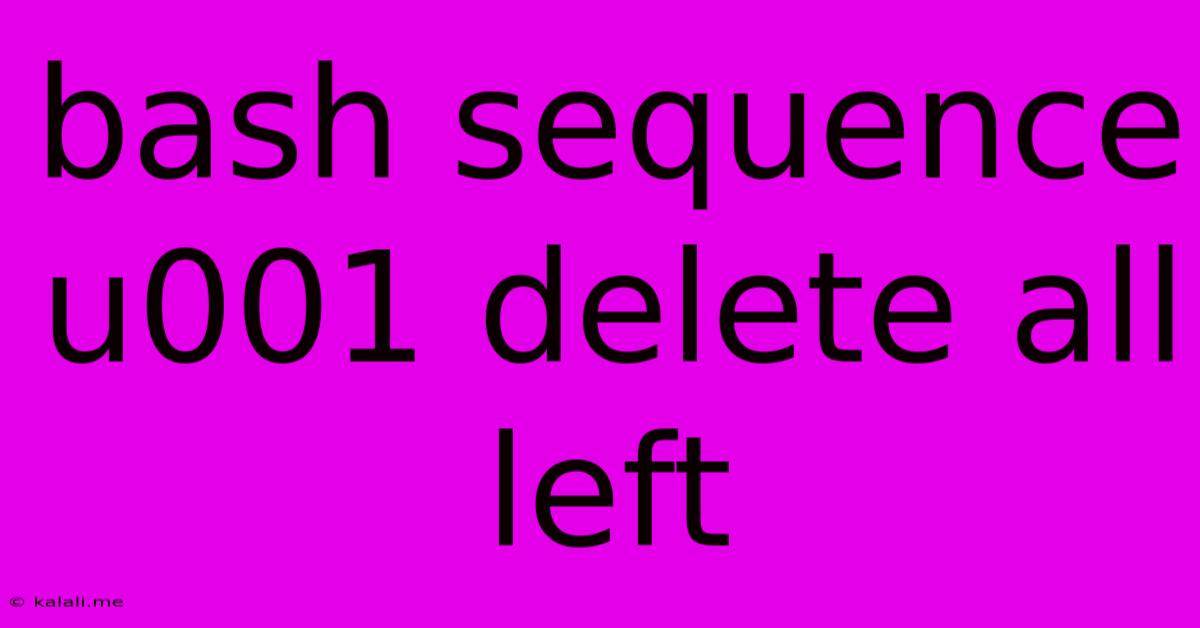Bash Sequence U001 Delete All Left
Kalali
May 24, 2025 · 3 min read

Table of Contents
Bash Sequence \u001: Deleting All Characters to the Left
The Bash sequence \u001 isn't directly associated with deleting all characters to the left of the cursor. There's no single escape sequence in Bash that performs this function. However, we can achieve this result using a combination of Bash commands and features. This article will explore several effective methods, catering to different scenarios and levels of Bash expertise. Understanding these methods will improve your command-line efficiency and your ability to manipulate text effectively within the Bash environment.
Understanding the Challenge: The difficulty lies in the fact that Bash interprets escape sequences differently depending on the context (e.g., within a text editor versus directly in the terminal). \u001 itself represents a control character (Start of Heading), not a command for text deletion.
Methods to Delete Characters to the Left:
Here are a few strategies to delete text to the left of the cursor in different contexts:
1. Using the Ctrl + u Shortcut:
The simplest method, applicable within most Bash terminal emulators, is the keyboard shortcut Ctrl + u. This universally recognized shortcut efficiently deletes all characters from the cursor to the beginning of the current line. This is the most direct and efficient solution for most users.
2. Employing readline Editing Capabilities:
Bash's readline library provides a rich set of editing capabilities. While there's no single command to delete everything to the left, you can use a combination of readline features:
Ctrl + k: Deletes from the cursor to the end of the line.Ctrl + a: Moves the cursor to the beginning of the line.Ctrl + w: Deletes the word before the cursor.
By strategically combining these, you can effectively delete to the left. For example, Ctrl + a followed by Ctrl + k clears the entire line.
3. Programmatic Approach with sed or awk:
For more advanced scenarios, where you're dealing with text stored in a variable or file, you can leverage powerful text processing tools like sed or awk.
Example using sed:
Let's say you have a string stored in the variable my_string:
my_string="This is a long string."
To remove everything before "long", you would use:
new_string=$(echo "$my_string" | sed 's/.*long/long/')
echo "$new_string" # Output: long string.
This sed command uses a regular expression to replace everything before "long" with just "long". You can adapt this to your specific needs by modifying the regular expression.
Example using awk:
awk offers similar capabilities. Consider the same scenario:
my_string="This is a long string."
new_string=$(echo "$my_string" | awk '{print substr($0, index($0, "long"))}')
echo "$new_string" # Output: long string.
This awk script finds the index of "long" and prints the substring from that point onwards.
Choosing the Right Method:
The optimal approach depends on your context:
- For interactive shell use,
Ctrl + uis the quickest and most user-friendly solution. - For scripting or manipulating text within a variable,
sedorawkprovide powerful and flexible options. - Understanding
readlinecapabilities gives you fine-grained control over the editing process.
This comprehensive guide helps you effectively delete text to the left of the cursor in various Bash contexts. Remember to select the method most suitable for your specific scenario and skill level. Remember to always back up important data before performing any text manipulations.
Latest Posts
Latest Posts
-
What Is 1 2 Equivalent To In Fractions
Jul 06, 2025
-
How Do You Say Pork In Spanish
Jul 06, 2025
Related Post
Thank you for visiting our website which covers about Bash Sequence U001 Delete All Left . We hope the information provided has been useful to you. Feel free to contact us if you have any questions or need further assistance. See you next time and don't miss to bookmark.